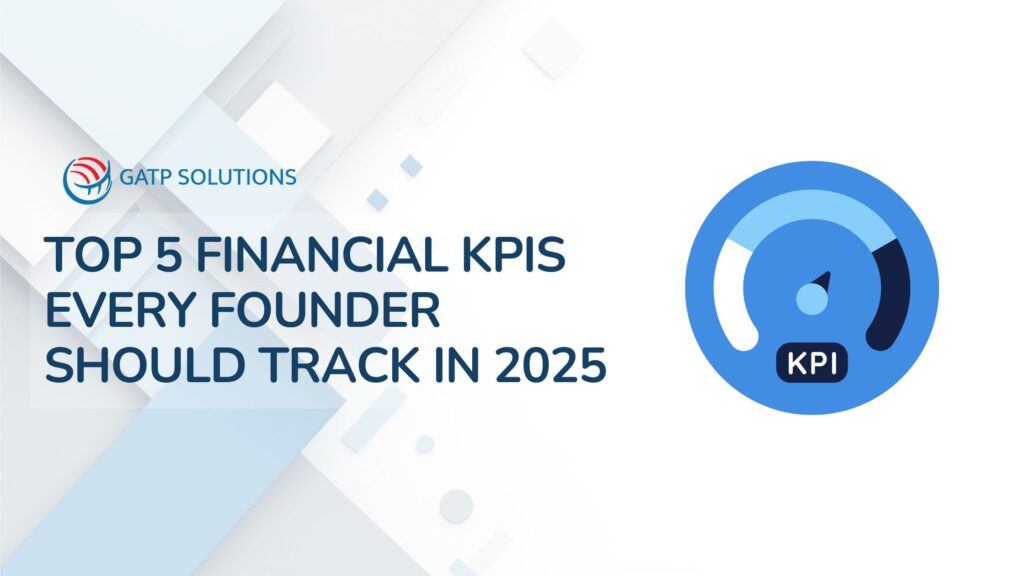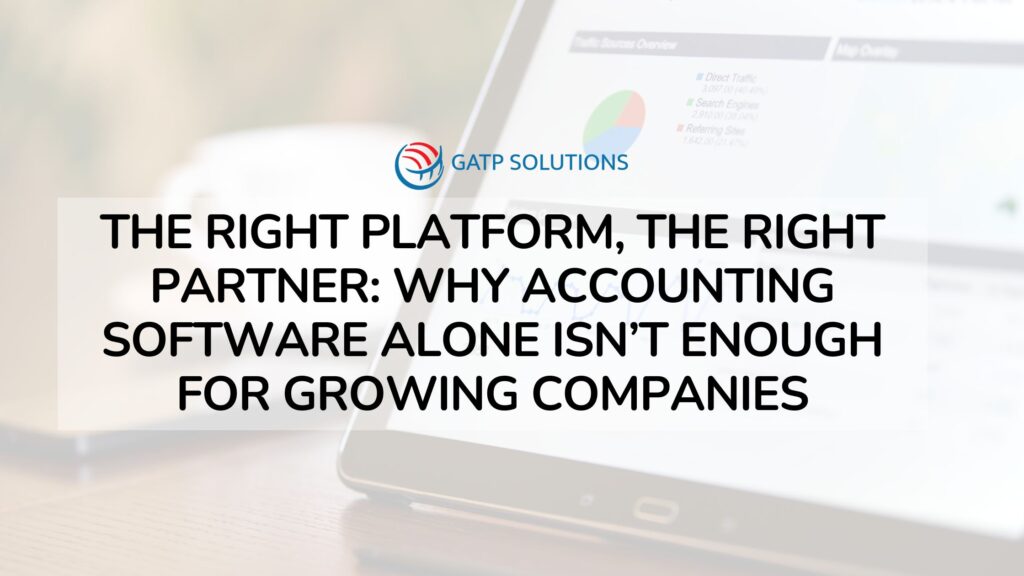Businesses today are dealing with one of the most unpredictable economic climates in years. Nowadays, it is harder for founders to secure funding, deal with rising costs, and manage investors who are no longer impressed by vanity growth. In such an environment, it is extremely important for founders to know which financial KPIs to track. This knowledge can be the major difference between scaling sustainably and running out of cash.
Contrary to popular belief, the challenge in such a situation is not lack of data, but to identify which numbers matter the most for decision-making. Even though companies can get a plethora of reports filled with financial metrics, following the wrong KPIs can severely affect their finances.
This blog walks through the five most important financial KPIs every founder should focus on. We will also understand the definitions, benchmarks, examples, and practical ways to apply them in strategy.
What Are Financial KPIs and Why They Matter
Financial KPIs are specific measures that indicate how well a company is performing financially. They are a part of financial metrics for the businesses.
For example, revenue is a metric. Revenue growth rate is a KPI because it shows whether the business is actually expanding. Similarly, profit is also a metric. Profit margin is a KPI because it reveals whether the company is operating efficiently.
Tracking KPIs helps founders in the following ways:
- They create a common language for communicating with investors and boards.
- They act as signals for potential risks before they become crises.
- They help teams align goals and measure progress.
- They provide context for financial decisions, such as when to hire, when to cut costs, or when to raise funding.
In short, KPIs turn raw data into insights that matter for the business growth
How Should One Select the Right KPIs?
For selecting the right KPIs for their business, founders should focus on the KPIs that:
- Lead to actionable decisions
- Allow for benchmarking against peers or past performance
- Cover multiple dimensions of financial health
- Reflect both short-term survival and long-term sustainability
By focusing on these indicators, founders can avoid analysis paralysis and concentrate on what truly drives the business forward.
The Top 5 Financial KPIs Every Founder Should Track
The following are the top 5 Financial KPIs every founders must track in 2025:
1. Operating Cash Flow (OCF)
Operating cash flow measures the cash generated from a company’s core business operations. Unlike net income, which can be influenced by accounting practices, OCF shows how much cash is actually available to pay bills, salaries, and investments.
Why It Matters
Cash is the most immediate indicator of survival for a business. A company can report profits on paper but still collapse if customers delay payments or expenses outpace collections. For founders, OCF shows whether the business model is sustainable in practice.
Benchmarks
- Positive OCF relative to revenue is a strong sign.
- Consistently negative OCF, even with rising sales, is a red flag.
To understand this better, let us take an example. A software startup records $1 million in annual revenue but has negative OCF of $200,000. And the reasons are that customers are paying late, and the company is front-loading expenses. So, even though the company has a good revenue record, without adjustments, it may still run out of cash within months.
2. Profit Margin
Profit margin is the percentage of revenue that remains after costs are deducted. Gross profit margin measures profitability after production costs, while net profit margin factors in all expenses.
Why It Matters
Profit Margins showcase how effectively a business can convert revenue into profit. They help businesses understand whether their pricing strategies are effective and if the cost structures are sustainable for growth.
Benchmarks
- Healthy gross margins vary by industry. For SaaS, 70 to 80 percent is common. For retail, 20 to 40 percent may be acceptable.
- Net margins should be positive over time, even if early growth requires heavy reinvestment.
For example, a SaaS company earns $1 million in revenue with $200,000 in costs. Its gross margin is 80 percent, which shows strong unit economics. However, heavy marketing expenses born by the company end up reducing their net margins. This will impact their overall profits in the long run. Hence, founders can use this insight to optimize spending while maintaining growth.
3. Burn Rate and Runway
Burn rate measures how quickly the business spends cash for their operations. Meanwhile, runway estimates how many months the company can operate before running out cash at the current burn rate.
Why It Matters
These KPIs are very important for startups and growth-stage businesses. They show how long the company can survive without any new funding. During funding discussions, investors always ask the founders about runway. Hence, founders need to be very careful while assessing their operations, burn rate, and deciding the runway for their company.
Benchmarks
- Twelve to eighteen months of runway is generally considered safe.
- Less than six months indicates urgent need for cost cuts or new funding.
Let us take an example. A company has $2 million in the bank and spends $250,000 monthly, and so the runway is eight months. Without new revenue or investment, the company will run out of cash within the year. Hence, the founder must either raise capital or reduce expenses to extend the company’s runway.
4. Revenue Growth Rate
Revenue growth rate measures how quickly revenue increases over a specific period, usually measured year-over-year or quarter-over-quarter.
Why It Matters
Growth showcases the market traction and scalability of the business. It shows whether the business is expanding its customer base and increasing sales or moving towards a loss. However, it is important to also consider the context of growth, as growth at any cost is not sustainable in the long run for any business.
Benchmarks
- Double-digit annual growth is attractive to investors.
- Growth should align with strong margins to be considered healthy.
For example, a retail company grows from $2 million to $2.6 million in annual revenue, on a 30 percent increase. On paper, this looks positive for the growth, but if gross margins have fallen due to heavy discounting, the growth may not be sustainable. This will turn the company soon towards making heavy losses and will impact the overall business survival.
5. Efficiency Ratios (Accounts Receivable Turnover / DSO)
Efficiency ratios track how quickly a company turns sales into actual cash. Meanwhile, accounts receivable turnover measures how many times receivables are collected in a year. And, days sales outstanding (DSO) tracks the average time it takes to collect payments.
Why It Matters
Even though a company may have strong sales, if their cash is tied up in unpaid invoices, it may not mean much as it will not contribute to growth in real time. Such poor efficiency can strain the working capital and slow down growth by huge measures.
Benchmarks
- Lower DSO is better, with 30 to 45 days considered healthy in many industries.
- Higher turnover ratios signal faster collections.
Let us take an example to understand this in depth. A manufacturer has $600,000 in receivables and a DSO of 60 days. The delay means cash is tied up for two months, which will limit the company’s ability to reinvest in inventory. Hence, by improving cash collections, the company frees up liquidity to support expansion and growth towards the business goals.
Additional Financial KPI Examples Worth Considering
In addition to the top five, founders may track other KPIs depending on their business model:
- Current Ratio: Compares current assets with current liabilities to assess liquidity.
- Debt-to-Equity Ratio: Shows how much debt is used to finance the business.
- Customer Acquisition Cost (CAC): Measures the cost of acquiring a new customer.
- Lifetime Value (LTV): Estimates the total revenue a customer brings over their relationship with the company.
- Budget Variance: Highlights gaps between planned and actual performance.
These financial KPI examples provide additional insights without overwhelming founders with unnecessary data.
Building a KPI Dashboard
A KPI dashboard helps founders track multiple indicators in one place. Whether it is a simple spreadsheet or a business intelligence tool, it helps founders gain clarity over their operations. The following are some of the best practices business can follow for their KPI Dashboard:
- Automate data collection to reduce errors
- Use charts and visualizations for quick insights
- Review weekly for operations and monthly for strategy
- Share dashboards with key stakeholders to improve accountability
Dashboards make it easier for businesses to connect their key financial metrics with real-world actions.
What are the Possible Pitfalls using KPIs?
Even though KPIs are powerful and help businesses operate efficiently, they can still be misused. The misuse can cost the founder their company’s growth and survival. Hence, founders should watch for the following pitfalls:
- Focusing on vanity metrics: By celebrating just website visits or social media followers without connecting them to revenue or cash flow can give founders a false sense of success. Though these metrics are important to an extent, they should not be the overall indication of growth.
- Ignoring data accuracy: KPIs showcase their strength based on the accuracy of the data fed into them. Any inaccurate accounting or outdated numbers make the KPIs misleading and will give wrong business projections to the founders.
- Overreacting to short-term results: A business may have single slow months in sales or some high growth sales months. The short term results don’t matter much in the long run. It is important to focus on trends over multiple months to understand the business functions and growth better.
- Using the wrong benchmarks: If the business is a tech startup but is comparing to a traditional manufacturer, it is bound to create distortions. Founders must always benchmark within their industry for accurate results and comparisons.
- Tracking too many KPIs: Businesses only need a handful of efficient KPIs for efficient growth tracking. Monitoring too many KPIs spreads the focus too thin and leads to unclear results and impact.
- Not acting on insights: If the company is gathering KPIs without taking decisions based on the KPIs, it is a wasted effort on everyone’s part. For example, a founder may notice a falling margin but may not adjust the pricing accordingly is a missed opportunity for growth and survival in different sectors.
- Failing to update KPIs: Businesses should not stick to the same KPIs forever. The right business KPIs change as a business grows. What matters today may not matter at a different growth stage of the business in the future.
How Founders Should Use KPIs Strategically
KPIs are proper leadership tools, and not just accounting measures. To gain the maximum benefit out of them, founders can use them to:
- Align internal teams by linking objectives to measurable KPIs.
- Strengthen investor confidence with transparent, data-backed performance updates.
- Guide decisions on pricing, hiring, and scaling based on trends.
- Identify risks early and make adjustments before issues escalate.
For example, a startup with strong growth but weak efficiency ratios may prioritize collections before pursuing expansion, which will hinder the growth in the long run and impact business goals and operations negatively. Founders who want expert guidance in interpreting and acting on these insights can benefit from a Virtual CFO service that provides ongoing financial strategy and KPI-driven decision support.
GATP Solutions: Turning KPIs Into Action
At GATP Solutions, we help businesses go beyond tracking numbers. Our services ensure that financial KPIs are tied to strategy and that the right financial metrics are monitored at the right time.
We design KPI dashboards, integrate automation tools, and provide advisory services that turn key financial metrics into actionable insights. Whether a company is preparing for a funding round, scaling operations, or improving cash collections, our team ensures that KPIs drive results.
Founders who work with GATP Solutions gain clarity, confidence, and a partner who understands that numbers only matter when they guide decisions.
Conclusion
The five KPIs highlighted in this blog : Operating Cash Flow, Profit Margin, Burn Rate and Runway, Revenue Growth Rate, and Efficiency Ratios are the foundation of financial health for any founder in 2025. They provide clarity in the plethora of data available and ensure that leaders make decisions grounded in financial reality.
Key Takeaways
- Operating cash flow shows if the business can sustain itself with real cash, not just reported profit.
- Profit margins highlight cost efficiency and pricing effectiveness.
- Burn rate and runway tell founders how long they can operate before raising more funds.
- Revenue growth rate signals market traction but must be paired with healthy margins.
- Efficiency ratios reveal how quickly sales are turned into actual cash.
- By tracking these indicators and layering in other financial KPI examples where appropriate, founders can communicate confidently with investors, manage risk effectively, and lead their businesses toward sustainable and long-term growth.
Frequently Asked Questions
1. What is the difference between financial KPIs and financial metrics?
Financial KPIs measure performance against goals, such as revenue growth or profit margin. Financial metrics are raw numbers, such as total revenue or expenses, that may not be directly tied to strategy. GATP Solutions often helps businesses define the difference so they track what really matters.
2. How many KPIs should a founder track at once?
Five to seven KPIs are usually enough. This allows for depth without overwhelming the leadership team. Companies that work with GATP Solutions often find clarity in narrowing down their focus.
3. Which financial KPIs are most important for startups?
Cash burn, runway, and revenue growth are critical for startups. These show if the business can survive, how long funds will last, and whether it is scaling. GATP Solutions provides advisory support to help startups prioritize the right mix of KPIs.
4. Why is cash flow more important than profit in the short term?
Cash flow determines whether the business can pay its bills. A profitable business can still fail if customers delay payments and cash is not available.
5. How often should financial KPIs be reviewed?
Weekly reviews are best for tactical operations, while monthly reviews provide a clear view for strategic planning. Quarterly reviews are common for board and investor updates.
6. What are healthy benchmarks for profit margin?
It varies by industry. SaaS companies often aim for gross margins of 70 to 80 percent, while retail companies may operate with 20 to 40 percent.
7. Can KPIs improve chances of securing funding with the help of GATP Solutions?
Yes. Investors want to see consistent trends in KPIs such as cash flow, margins, and growth rates. GATP Solutions helps founders prepare KPI reports that strengthen fundraising discussions.
8. Do all businesses need the same KPIs?
No. Each business should choose KPIs that reflect its model. For example, subscription businesses prioritize churn and LTV, while manufacturers focus on inventory turnover.
9. What tools are best for tracking KPIs?
Popular options include QuickBooks, NetSuite, and Xero for accounting. For analytics and visualization, tools like Tableau or Power BI help create dashboards. GATP Solutions also assists in integrating these tools into seamless systems.
10. What should founders do if a KPI trend turns negative?
The first step is to find the cause. If cash flow falls, is it due to delayed payments, higher costs, or declining sales? Once identified, action should follow, such as renegotiating terms, reducing expenses, or shifting strategy. GATP Solutions provides support in diagnosing issues and recommending corrective strategies.




